Report on the event, How Things Work Conference of 3/5/2024 at the Great Hall at City College.
PDF version (14.2 MB): Report-How-Things-Work-2024.pdf
The Environmental Education Projects Forum, a program of the Environmental Education Advisory Council (EEAC), is a network of environmental educators and professionals working together to create and implement systemic projects to support environmental and sustainability education in formal and non-formal settings.
Projects that emerged from Forum’s annual workshops include:
- Creating an online syllabi bank containing a collection of courses in environmental education available to colleges of education wanting to expand environmental concepts into their teacher preparation programs
- Supporting the idea that all persons have the right to learn how nature works which has led to several efforts to expand environmental rights and environmental education in New York State.
- Helping the CUNY Remote Sensing Earth Systems (CREST) Institute identify and collaborate with schools to receive weather stations so students can better understand climate change.
A recommended project that emerged from discussions held by participants in the sixth Forum workshop was the creation of a “How Things Work” program for students, modeled after the original YouthCaN conferences created by long-time New York University Professor and EEAC Secretary, Millard Clements. On March 5, 2024, “How Things Work” was held in the Great Hall of the City College of New York and sponsored by EEAC, City College of New York, CUNY CREST Institute, and the James Baldwin Outdoor Learning Center.
Two hundred middle and high school students, their teachers, and college students learned from 50 expert educators representing 16 government agencies and non-profit organizations about the way common and emerging environmental systems work. The interactions between students and exhibitors were rich and deep as the educators asked the youth probing questions and involved them in demonstrations and hands-on activities.
Students came from 02M427, Comprehensive Model School Project, IS 383 Philippa Schuyler Middle School, PS/IS 184, New Heights Middle School, John Dewey High School, Bronx Writing Academy, MS 244, Lincoln High School, and City College of New York.

A keynote address was presented by Matthew Washington, Vice President and Chief of Staff for Phipps Houses.
Matthew talked about the experiences which launched him into a career in community and public service. As a teenager he led a campaign in his East Harlem neighborhood to convince the local Costco to accept food stamps. He also attended the High School for Environmental Studies which reinforced his interest in environmental preservation. He talked about how in his work at the nonprofit housing developer, Phipps, he stresses the importance of using environmentally benign construction materials, installing solar collectors on rooftops and water collection tanks on the properties to prevent runoff and combined sewer overflow. Students and teachers responded enthusiastically to his presentation.
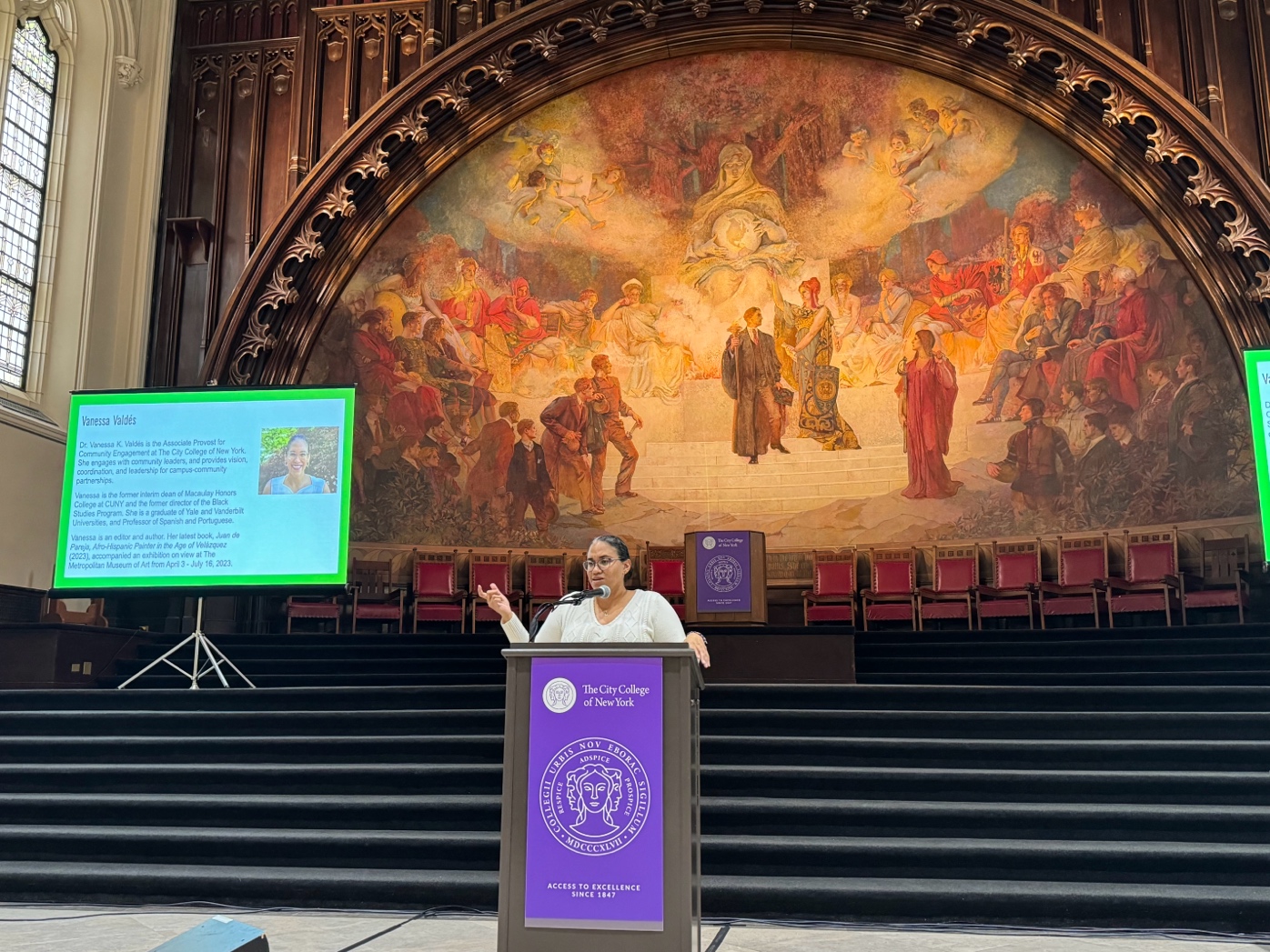
Vanessa Valdes, City College of New York Vice Provost for Community Engagement, also spoke of how her experiences growing up in New York City fueled her community activism. She related how attending college inspired her to become a scholar and combine her academic skills with public service to function effectively in her current position.
Additional speakers included City College of New York student, Richard Rivera, and Cole Frost, New York University student intern from the Climate and Resilience Education Task Force. Ray Pultinas, EEAC and James Baldwin Outdoor Learning Center, explained how this conference was inspired by the YouthCaN conferences held at the American Museum of Natural History over a 20 year period starting in the 1990s.
The general feeling in the Great Hall was relaxed and congenial. As one participant said of the conference:
Indeed, a great success. Kudos to everyone involved and to the exhibitors for making their presentations incredibly engaging for the students, to the teachers for knowing the importance of environmental education for their students and for traveling from near and far even though the weather was challenging. Three words: wonderful, engaging, impactful.”
(Cesar Ortiz)
HOW THINGS WORK EXHIBITORS AND DEMONSTRATIONS
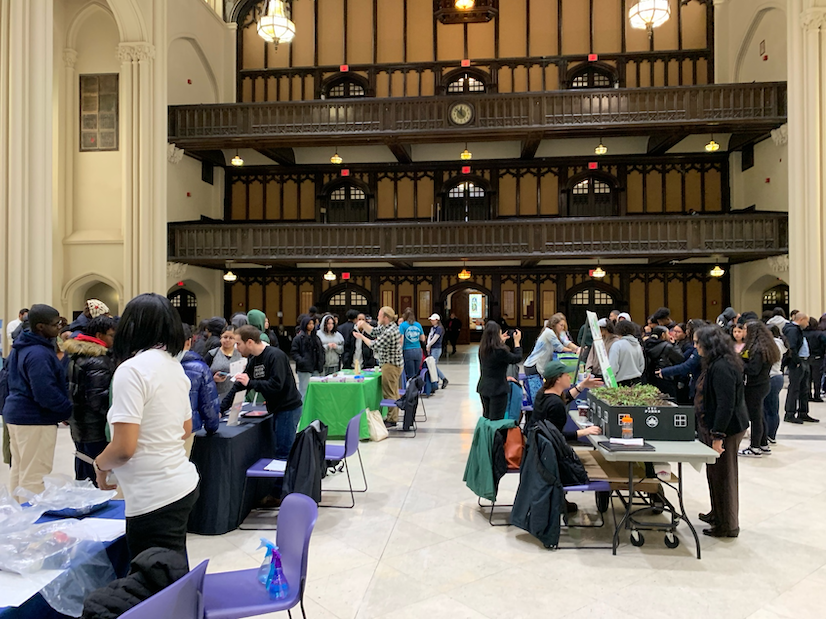
SOLAR ONE: How a Solar Collector Works
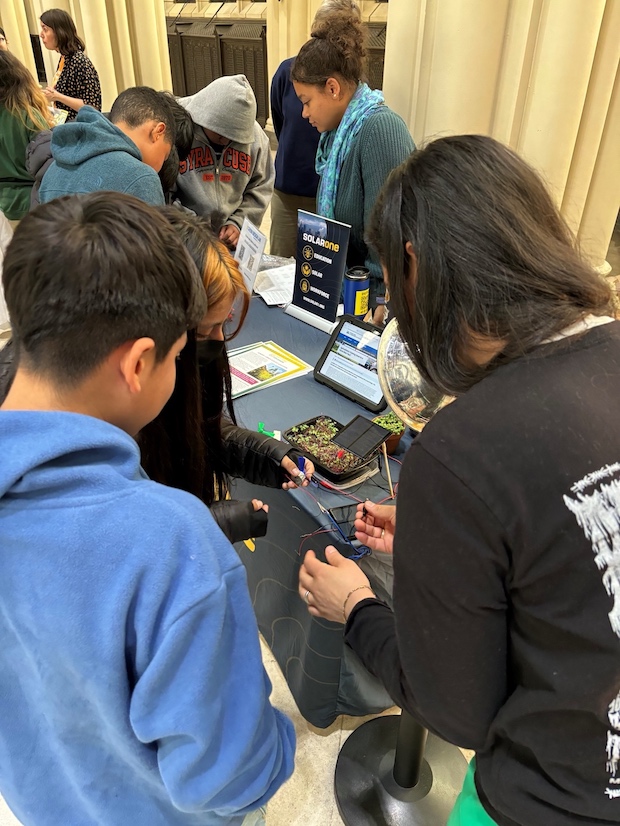
Solar One staff beamed light energy from a lamp onto a small array of photovoltaic solar cells, absorbing the light energy. This in turn caused the cell material, probably silicon, to generate a flow of electrons becoming an electric current, which then turned into mechanical energy of a small spinning turbine. This model demonstrated the First Law of Thermodynamics, “that energy can neither be created nor destroyed, only changed from one form to another.”
NEW YORK CITY DEPARTMENT OF ENVIRONMENTAL PROTECTION (DEP): How the NYC Water Supply and Wastewater Treatment Systems Work
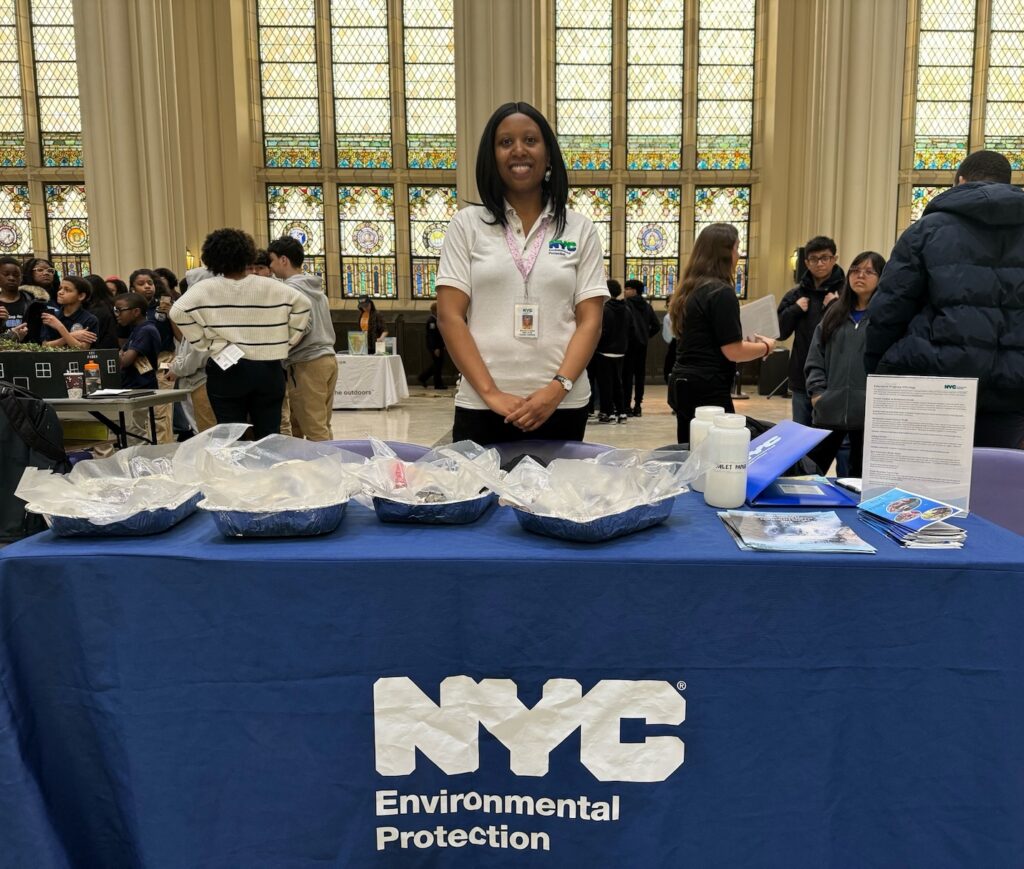
DEP staff engaged students in a watershed building and rainfall exercise in which youth sprayed water on a model watershed, observing the runoff over the “hills” and landscape created by the crushed newspaper, plastic sheets and paper towels in the model.
Students learned that it is essential for the areas around the city’s upstate reservoirs to be surrounded by ample vegetation – trees and other native plants, which can absorb rainfall and filter pollutants and impurities in rainwater and on the land before water fills the reservoirs.
Over nine million people in NYC and Westchester County receive about one billion gallons of water daily from 19 reservoirs east and west of the Hudson River (in the Croton, Catskill and Delaware Watersheds). Water ultimately travels to our homes through aqueducts and tunnels by the force of gravity.
DEP also involved the youth in activities which demonstrated what happens to water after we use it. Students learned that wastewater travels from our homes into sewers and then into one of 14 wastewater resource recovery facilities where it is treated with primary (physical) and secondary (biological) treatment that together remove about 90% of the bacterial and viral content. Most of the remaining pathogens are killed by chlorination disinfection before the effluent is released into the waters around the city. The waters are at that point “fishable and swimmable” but not drinkable.
DEP staff also covered why combined sewer overflows occur during and after heavy rainfall. Stormwater runoff can sometimes overwhelm the wastewater treatment system thus releasing untreated water into the waters surrounding the city. Curbside rain gardens and other, more absorbent landscape features (as well as reducing water use during rain events), are designed to prevent harbor water pollution and the cessation of water related activities.
THE BILLION OYSTER PROJECT: How Oysters Work to Protect Water Quality
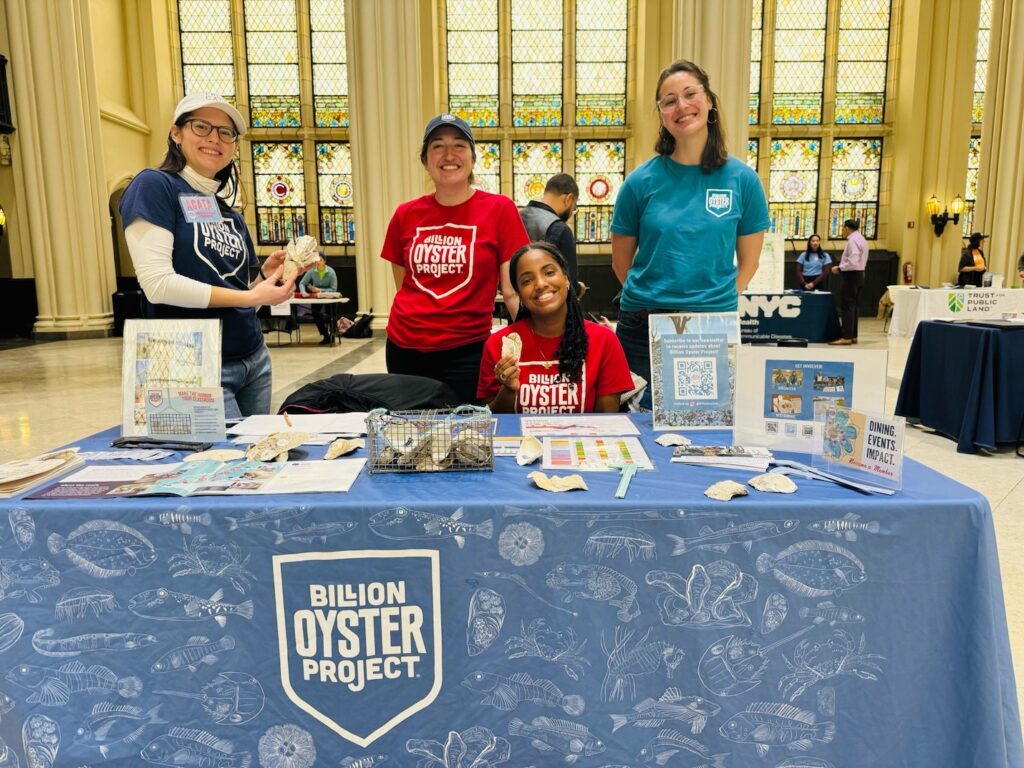
The goal of the project is to engage one million people in restoring one billion oysters to NYC’s harbor by 2035. Students learned that oysters are filter feeders and serve as natural water filters, removing algae and excess nutrients. A single oyster can filter more than 50 gallons of water a day. Oyster reefs provide habitat for hundreds of species and protect water from storm damage, softening the blow of large waves. They reduce flooding preventing erosion along shoreline areas. The exhibit included materials demonstrating these functions as well as descriptions of how to plant an oyster reef.
THE NEW YORK CITY DEPARTMENT OF PARKS AND RECREATION: How a Green Roof Works

Utilizing a realistic replica of a green roof replete with actual soil and plants, staff from Parks’ Sustainable Facilities were able to help youth observe and feel the impact of a green roof. The roof absorbs rainfall helping plants to grow and preventing runoff onto the streets below and into the sewer system.
The green roof system cools buildings in warmer weather and prevents combined sewer overflows by helping to reduce untreated sewage into coastal waters during and after heavy rainfalls.
The exhibitors described the four types of green roofs: extensive, pre-planted with shallow soil depth containing moss, herbs and grasses requiring minimal maintenance; intensive, planted with deep soil depth with a wide range of plants requiring regular maintenance; modular, a green roof structured in trays and mats that contain plant and water retention material; and monolithic, a roof membrane in one layer, e.g., a silicone roof coating system.
WHYMAKER: How a Windmill Works
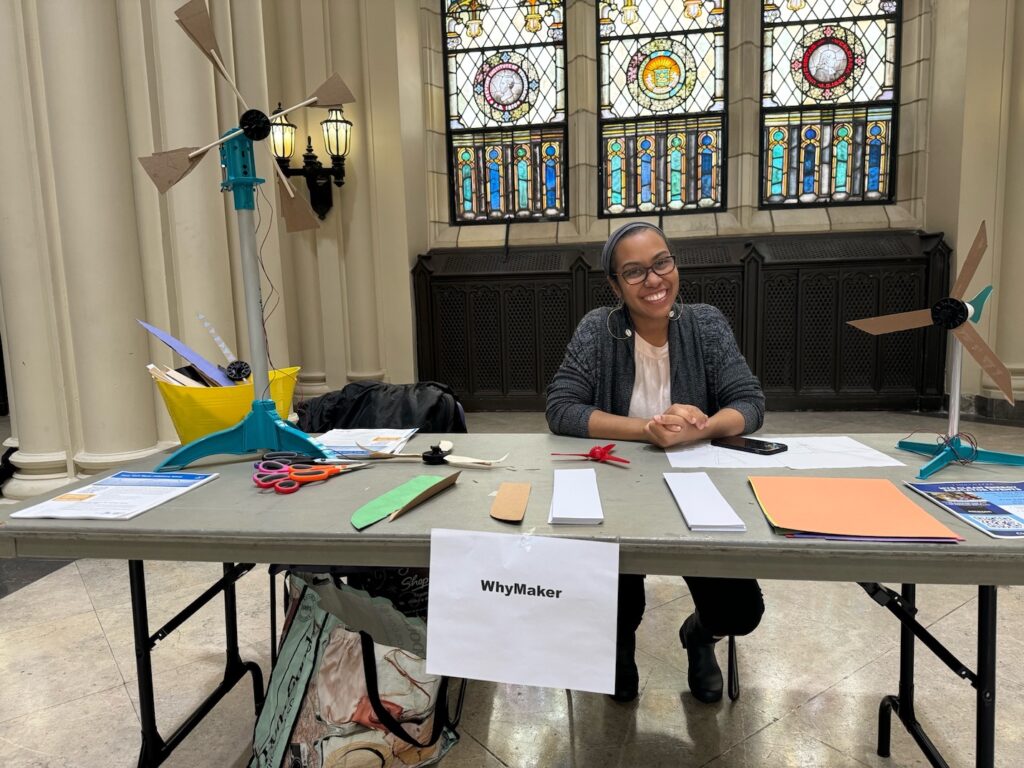
Students built mini-windmills from cutouts by analyzing the shape and length of the vanes. They shaped the vanes so they would move through the air in the most efficient manner possible if they were part of an actual windmill. The exhibit included a large model windmill which was used to show the students how windmills work. They learned that the mechanical energy of the wind turns the wind turbine which has a generator with an enclosed magnet inside a coil creating, based on the principle of induction, an electric current.
NORTH BROOKLYN PARKS ALLIANCE: How to Build a Native Plant Nursery in NYC
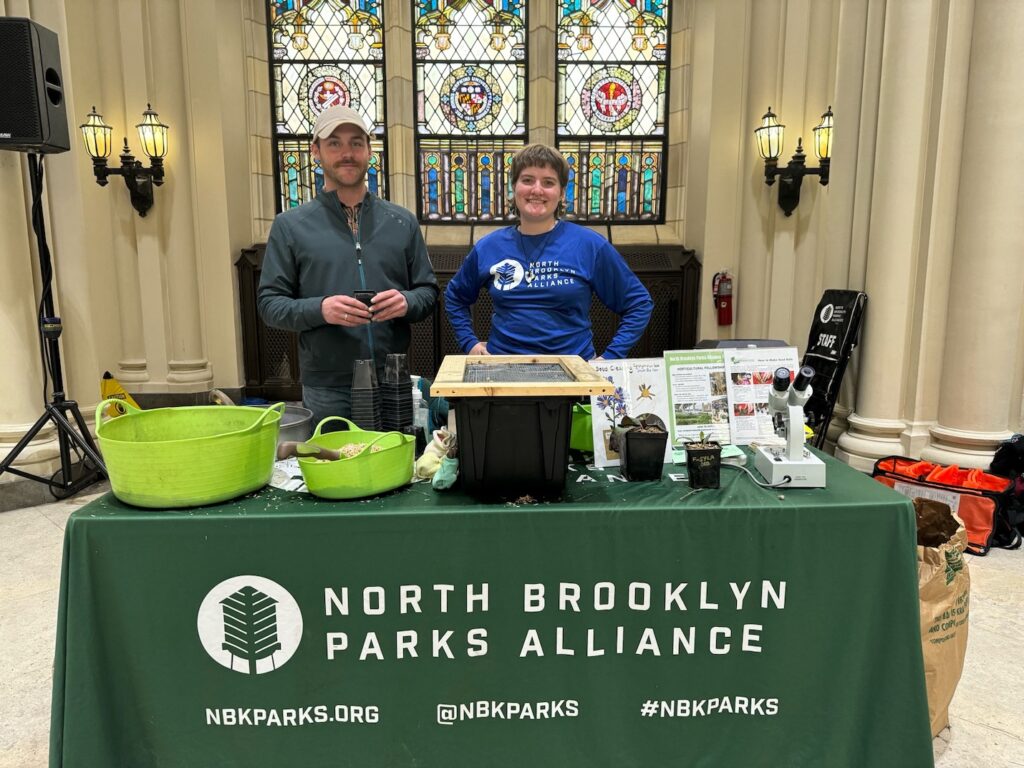
Based on their native plant nursery “Under the K Bridge” in partnership with multiple city agencies and non-profit organizations, staff brought seeds harvested from their nursery to demonstrate how seeds are collected and cleaned. Their exhibit included trays of seedling plants to show these processes and their seed germination action research.
The exhibitors stressed that they were not experts but community members. The exhibit helped to demystify plant evolution and the plant nursery process. Students harvested plant seeds and learned that the nursery depended on donations of reused materials such as plastic flats, soil amendments from local business waste and burlap bags from coffee roasters.
THE BRONX IS…BLOOMING: How to Make a Seed Bomb
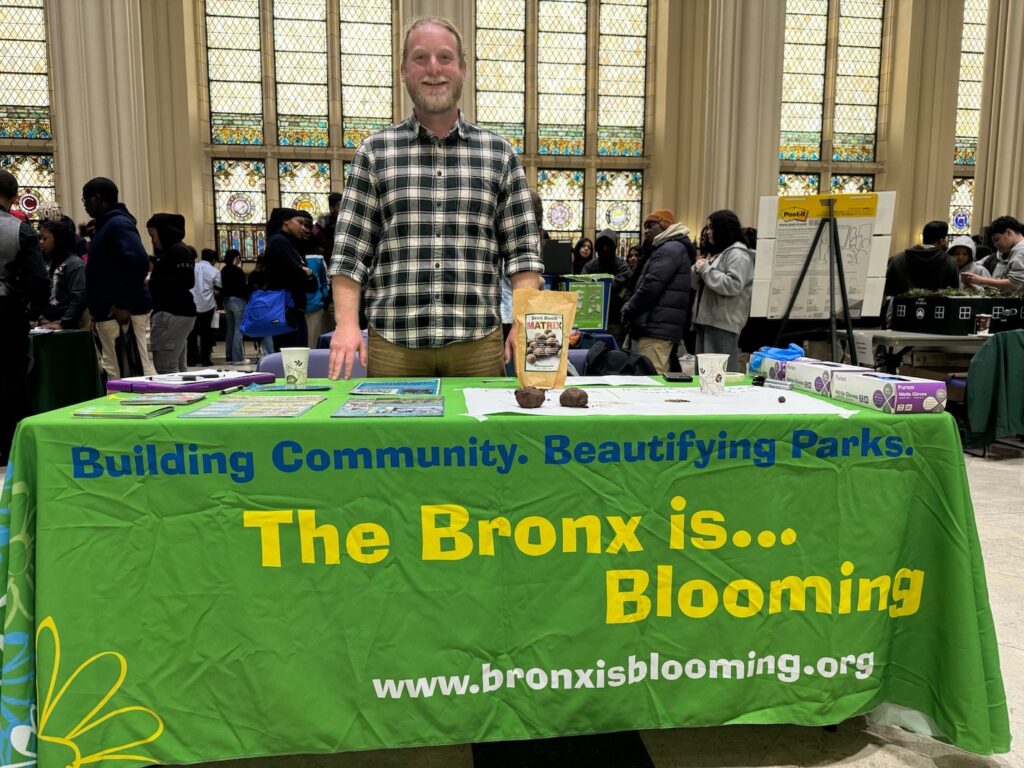
Students made a “seed bomb” with clay matrix and native plant seed. They learned how to employ this process to select seeds and plantings that improve the ecological quality of green spaces, i.e., biodiversity and resilience, when urban gardening. Students also learned about the multiple programs offered by the organization and the potential for their involvement.
THE SANITATION FOUNDATION: How Waste is Processed Beyond Curbside Pickup
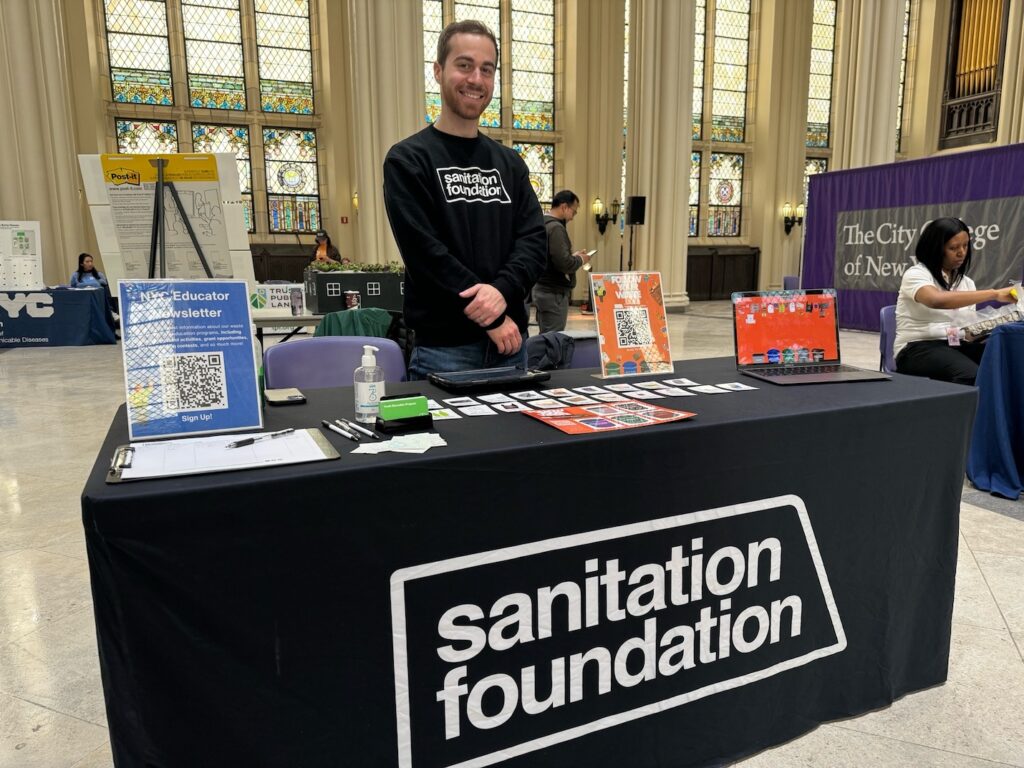
Students played “Follow Your Waste,” a game created in partnership with the NYC Department of Sanitation (DOS). Students selected one of several waste streams (organic, mixed paper, e-waste, etc.) and observed how it is processed beyond curbside pickup. The 10,000 tons of daily residential waste that is not recycled is sent to landfills and incinerators in other states, such as Ohio, Pennsylvania, Virginia and South Carolina. Much of Manhattan’s waste is incinerated across the Hudson River in New Jersey.
The 2,000 tons of daily garbage that is recycled is collected by the NYC Department of Sanitation. Vibrating machines separate cardboard and paper. Different types of paper are sorted by hand and baled. Paper is then loaded onto a barge and transported to the recycling plant run by Pratt Industries on Staten Island. Paper is processed into pulp. After the pulpling process is completed in about three hours, the finished product is a 25-ton roll of paper. More than 1,000 tons of recycled paper are created each day. Remaining recyclables at the DOS facility continue on a conveyor which uses magnets to remove steel cans. Different types of plastics are identified and separated using optical scanners. Metal, glass, plastic, and cartons are taken to the Sunset Park Materials Recovery Facility in Brooklyn. New York City identifies vendors who will pay to obtain the paper and metal materials and a small percentage of the plastics.
SMR/BALCONES RECYCLING: How To Recycle in NYC Schools and Homes
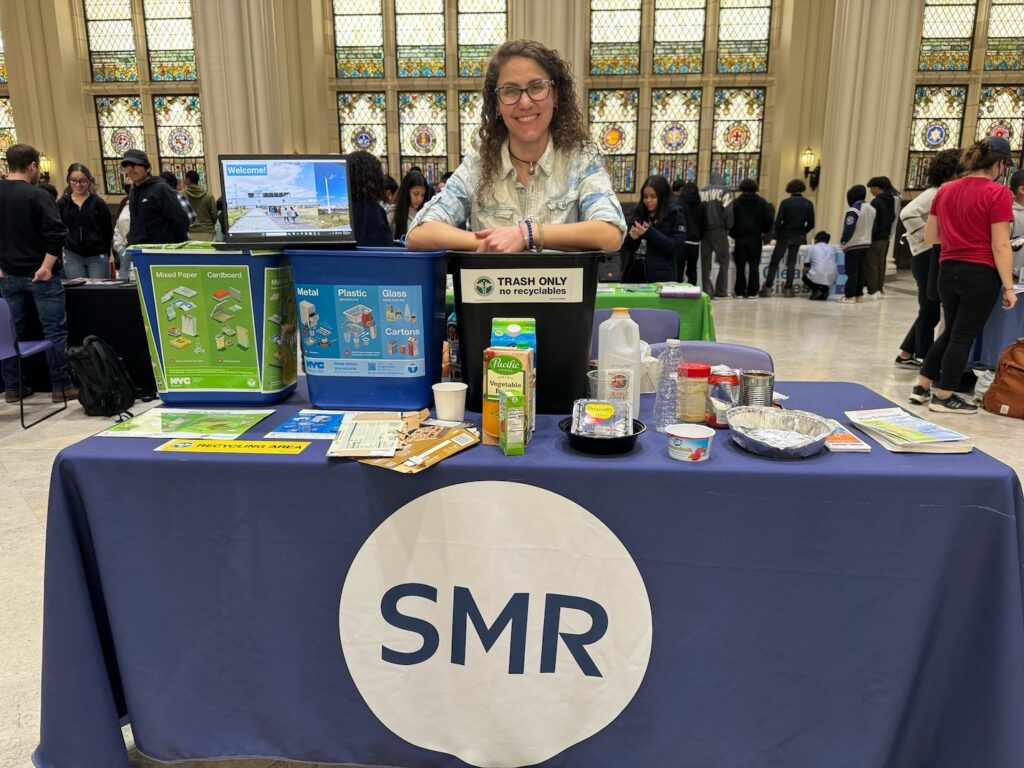
The exhibit included a sorting activity which demonstrated what is and isn’t recyclable. Participants learned where their recyclables go and ideas for reducing and reusing the materials they use.
NEW YORK LEAGUE OF CONSERVATION VOTERS EDUCATION FUND: How an Electric School Bus Works
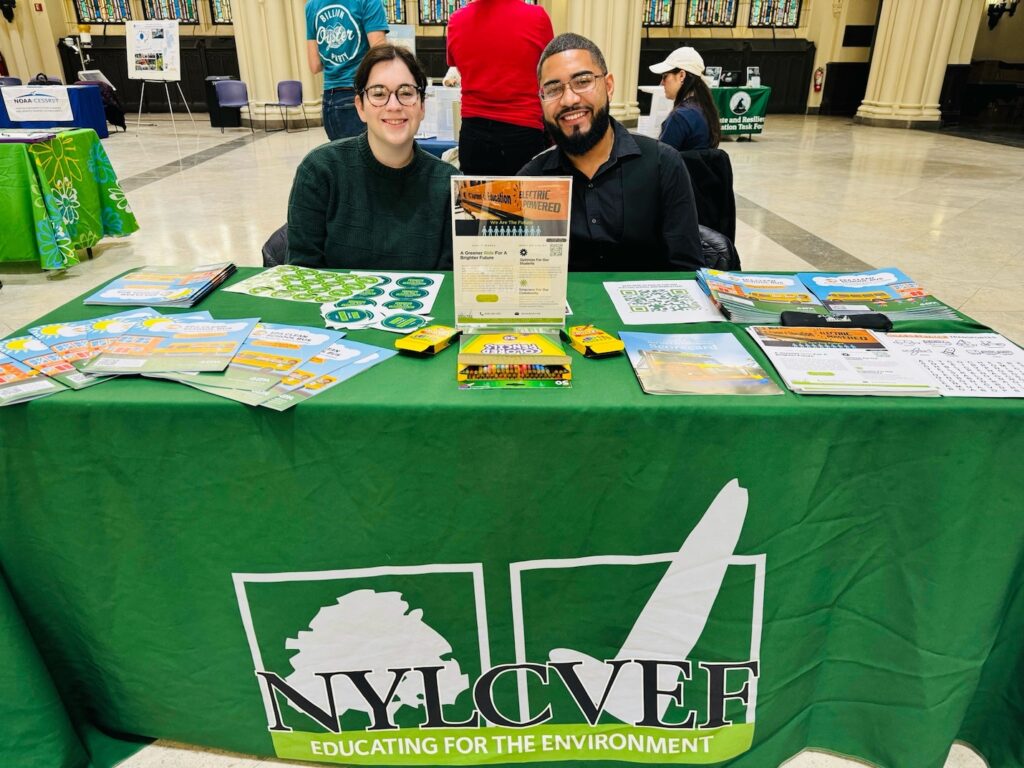
Electric school buses significantly decrease greenhouse gas emissions compared to traditional diesel buses, helping combat climate change by utilizing renewable energy sources for charging. Electric school buses use a battery pack to store electrical energy that powers the drive motor. Batteries are charged by plugging the bus into an electric power source.
EMPIRE CLEAN CITIES: How a Hydrogen Fuel Cell Bus Works
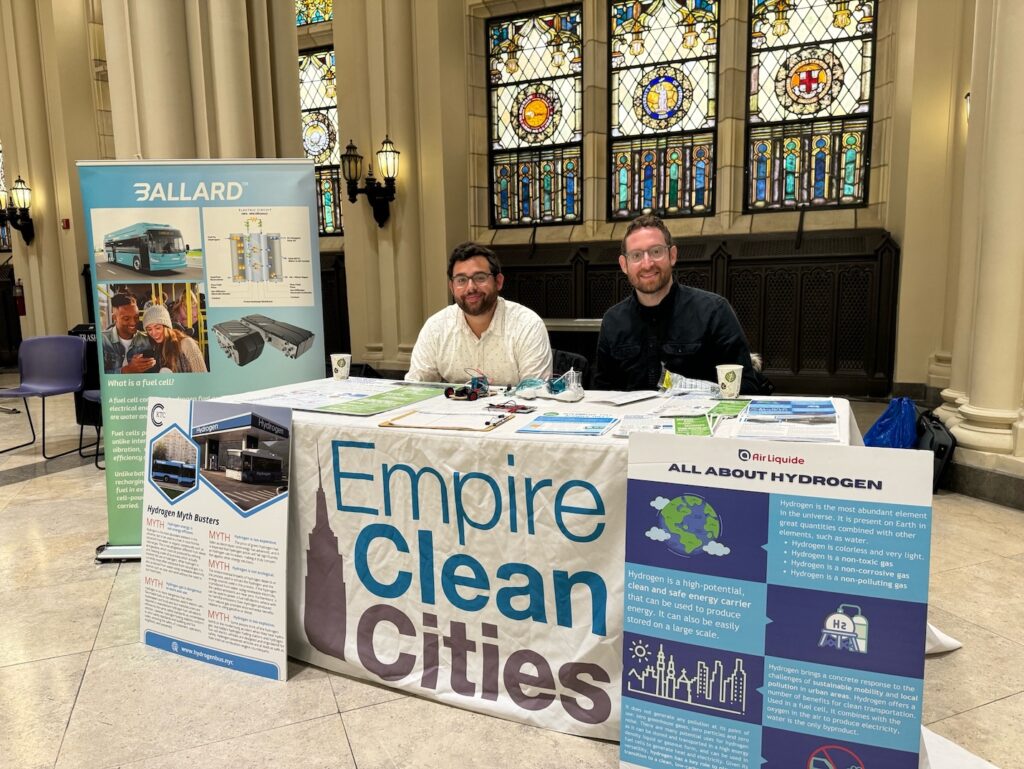
Hydrogen fuel cells generate electricity by reacting hydrogen and oxygen in the presence of a catalyst, the byproduct of which is water. The catalyst separates hydrogen molecules into protons and electrons. The electrons go through an external circuit, creating a flow of electricity. This electricity is used as the power source for an electric motor which drives the wheels of the bus.
The exhibit featured demonstrations and educational materials about how hydrogen fuel cell buses work and the benefits of this type of vehicular transportation.
LOWER EAST SIDE ECOLOGY CENTER: How Composting Food Waste Helps to Combat Climate Change and Promote Environmental Stewardship

Through visual representations, resources to start composting at home and a worm bin for hands-on exploration, students learned that composting food waste is not only an easy stewardship action individuals can take but it also has comprehensive and far-reaching environmental benefits, including reductions in greenhouse gas emissions, enhancements in soil quality and improvements in community resiliency.
Students observed that naturally occurring microorganisms, bacteria and insects and worms break down organic materials such as grass clippings, leaves and some kitchen scraps into compost, a soil-like product.
NOAA-CESSRST (NATIONAL OCEANIC AND ATMOSPHERIC ADMINISTRATION COOPERATIVE SCIENCE CENTER FOR EARTH SYSTEM SCIENCES AND REMOTE SENSING TECHNOLOGIES) AND CUNY CREST (CUNY COOPERATIVE SCIENCE CENTER FOR EARTH SYSTEM SCIENCE AND REMOTE SENSING TECHNOLOGIES CENTER): How A Weather Station Works
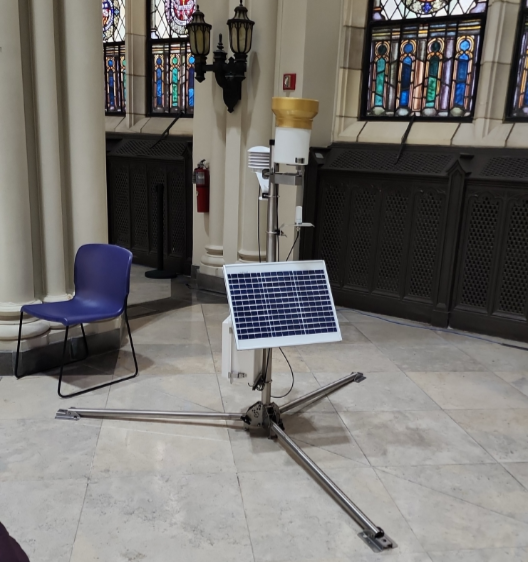
Staff and college students demonstrated a mini-weather station which is currently operating in 21 NYC schools with four more soon to be installed. Using multiple sensors and data loggers the stations monitor meteorological and hydrological conditions around NYC to get more in-depth and cross-sectional weather real-time data to support research studies on weather, water and climate. Stations monitor air temperature, relative humidity, precipitation and soil moisture every 15 minutes each day.
NYC DEPARTMENT OF HEALTH AND MENTAL HYGIENE (DOH): How Climate Change Contributes to Mosquito-Borne Disease in NYC, How Diseases are Transmitted by Mosquitos and How Disease Can be Prevented
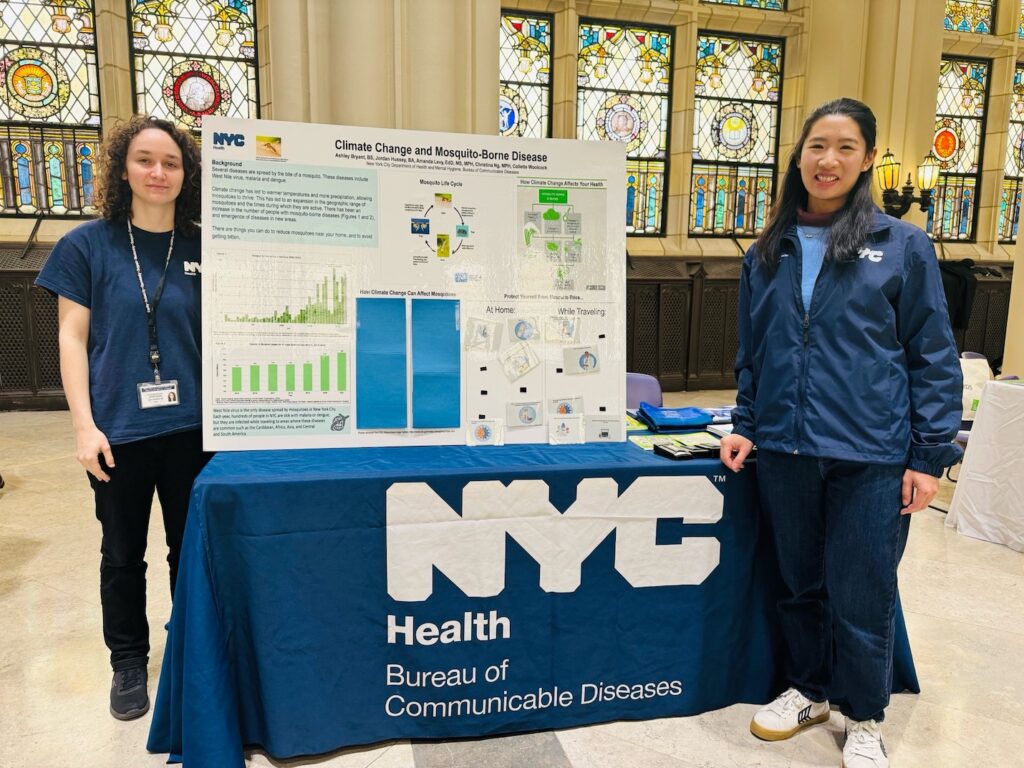
Agency scientists demonstrated to students how climate change contributes to mosquito-borne disease. Climate change can lead to an increase in infectious diseases transmitted by mosquito and tick bites such as Lyme disease or the West Nile virus. These diseases may spread to previously unaffected areas as warmer temperatures provide better conditions for mosquitoes and ticks to live.
Students also learned about the interventions which can prevent the transmission of disease such as wearing long sleeves, mosquito repellent, removing standing water sources, and vaccinating against vector borne diseases when traveling outside the United States.
TRUST FOR PUBLIC LAND: How Greenery Absorbs Water, Prevents Runoff and Helps to Reduce the Impact of Climate Change

A game, puzzle and map were used to demonstrate the benefits of plants and thoughtful landscaping to prevent flooding and runoff of pollutants into coastal waters. Images from the outstanding book “Mannahatta: A Natural History of New York City” by Eric W. Sanderson, which details New York’s lush, green environment during the time it was inhabited by Native Americans, were used to highlight the importance of natural areas to absorb and redirect rain water.
DURO/UAS: How to Evaluate Water Quality by Measuring pH and Oxygen-Reduction Potential
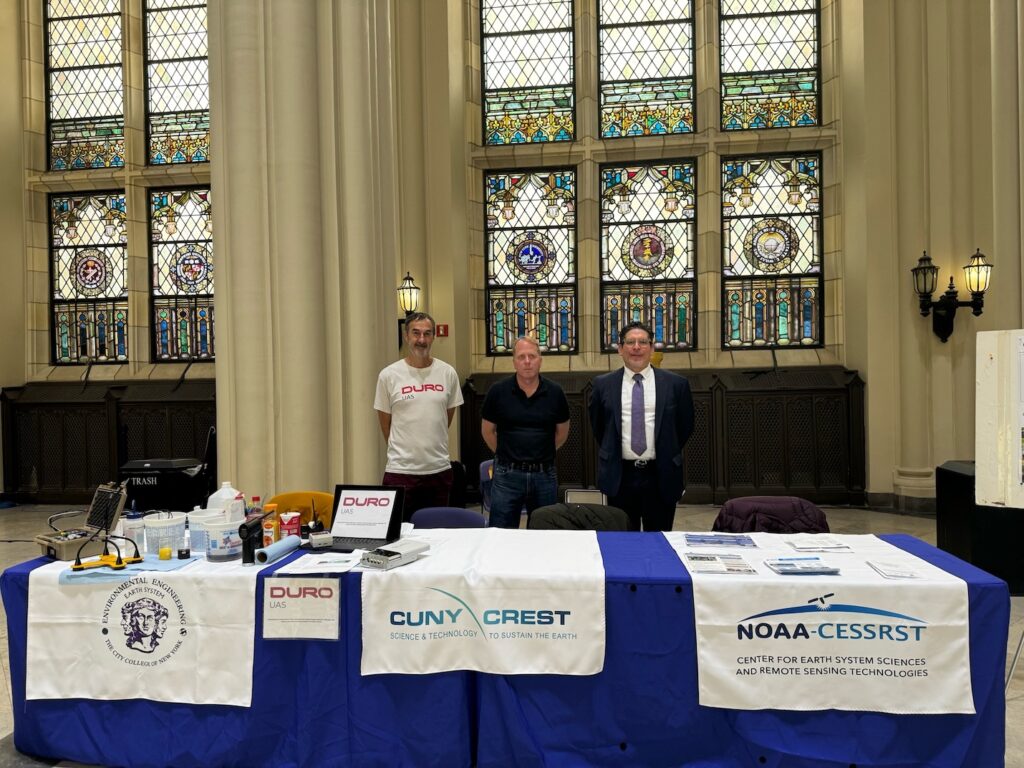
Using probes and other scientific tools, students tested various household items such as orange juice, soda, tap water and soapy water for pH and Oxygen-Reduction Potential. Students learned, for example, that tap water usually has a neutral pH and must be monitored to ensure that the pH remains approximately between 6.5 and 7.5.
CLIMATE AND RESILIENCE EDUCATION TASK FORCE and the NEW YORK CITY COMPTROLLERS OFFICE: How to Promote Climate Change Education in New York State
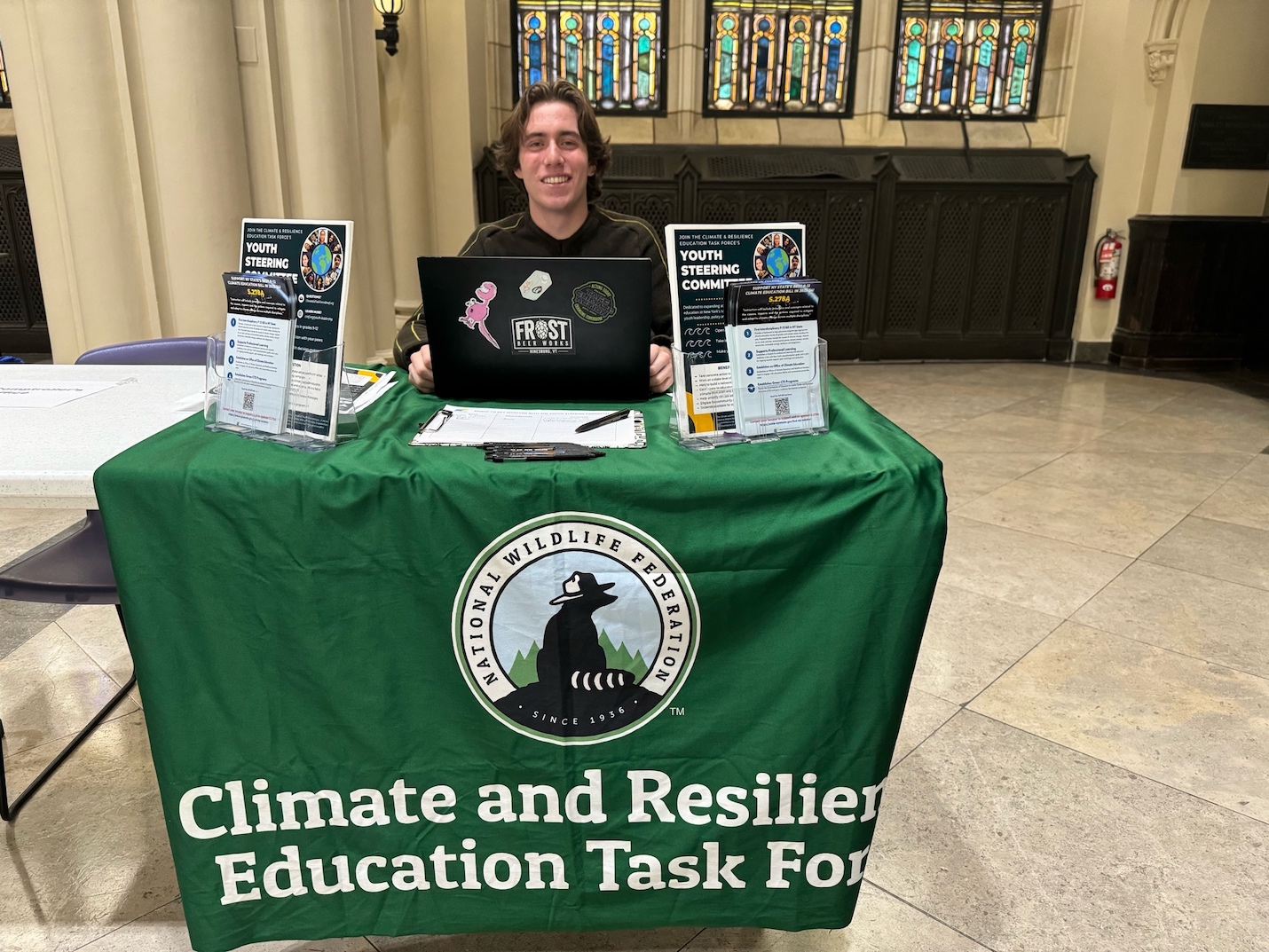
Exhibitors displayed and distributed information about the climate change education legislation currently being considered by the state legislature. The bill would dramatically expand support for in-classroom learning and teacher education on climate and establish an office of climate change education to implement and monitor the provisions in the law. Materials included information on how to work through the legislative structure to get the bill passed. Task force exhibitors also informed students about the steering committee which coordinates the task force and the opportunity for youth involvement.
New York City Comptroller Brad Lander’s office shared information about school-based resilience hubs, spaces that can provide students with programming, resources and information to address climate change.
The conference organizing committee consisted of many people who were responsible for the planning and implementation of this outstanding program. A special recognition goes to Robin Sanchez for her leadership, hard work and dedication. The team included the following members:
Kim Estes-Fradis, EEAC member
Jay Holmes, EEAC member and American Museum of Natural History
Bethany Kogut, EEAC Steering Committee
Shakila Merchant, CUNY CREST
Cesar Ortiz, CUNY CREST
Ray Pultinas, EEAC Steering Committee and James Baldwin Outdoor Learning Center
Robin Sanchez, EEAC Steering Committee and NYC DEP
Andy Stone, EEAC member
Dan Tainow, EEAC Steering Committee and NYC Urban Park Rangers
Srishti Tyagi, CUNY CREST
Ilana Weinstein, EEAC Steering Committee and City Parks Foundation
Mike Zamm, EEAC Steering Committee Emeritus
Report Prepared by Mike Zamm, EEAC Environmental Education Projects Forum
